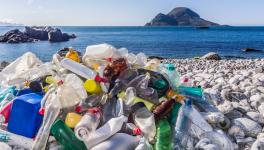Human Construction Activity has Modified 30,000 Square Kms of the Oceans
Image Courtesy: Wikimedia Commons.
Owing to the increasing needs of lavish modern societies which demand extravagant energy and various other necessities, human beings have subjected close to 30,000 square kilometres of ocean to construction activity, a recent study has said.
Different kinds of infrastructure – including tunnels and bridges – for the extraction of oil and gas, wind farms, ports and marinas, aquaculture infrastructure and artificial reefs are some of them.
A research group from The University of Sydney, Australia, has mapped the extent of human construction activity in oceans. The research, a first of its kind, was published in the journal Nature. According to the findings reported in the study, an area totaling 30,000 square kilometers of oceans has already been modified by such construction activitity.
The extent of modification of the oceans by human construction is said to be comparable to the extent of urbanised land. It goes beyond the global area covered by some natural marine systems, such as mangrove forests and sea-grass beds.
If the total effect of such constructions, such as a change in water flow and pollution, is gauged, the total area goes much higher—almost two million square kilometers, approximately 0.5% of the oceans.
Commenting on the findings, Dr. A.B. Bugnot of the School of Life and Environmental Sciences, University of Sydney, reportedly said that ocean development is not a new phenomenon, but that it has undergone rapid change recently. “It has been ongoing since before 2000 BC. Then, it supported maritime traffic through the construction of commercial ports and protected low-lying coasts with the creation of structures similar to breakwaters,” she was quoted saying.
Since the mid-20th century, however, ocean development has ramped up, producing both positive and negative results.
She said that while artificial reefs “have been used as a ‘sacrificial habitat’ to drive tourism and deter fishing, this infrastructure can also impact sensitive natural habitats like seagrasses, mudflats and salt marshes, consequently affecting the water quality.”
She added that marine development mostly happened in areas near the coast, said to be “the most biodiverse and biologically productive ocean environments.”
The study also projected what we could expect from the expansion of the ocean construction footprint, and it is alarming. Infrastructure for power and aquaculture, includling cables and tunnels, are projected to have an increase of between 50% and 70% by as early as 2028. However, according to Bugnot, this is an underestimation, and that there is a scarcity of information on construction in oceans as a result of poor regulation of the activity in many parts of the world.
The projected expansion of construction activities in oceans, according to the researchers, are attributable to the increasing need of people for defence against erosion and flood in the coastal areas due to the rise in sea levels caused by climate change. This accompanies the increasing need of transportation, energy extraction as well as recreational needs.
The quantification of the extent of oceanic modification due to construction activity and the alarming projection for the future calls for an urgent and improved management of marine environments.
Get the latest reports & analysis with people's perspective on Protests, movements & deep analytical videos, discussions of the current affairs in your Telegram app. Subscribe to NewsClick's Telegram channel & get Real-Time updates on stories, as they get published on our website.

















